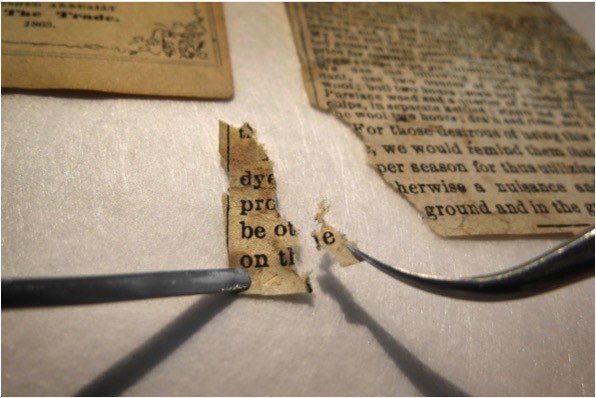
Human history comes with a long paper trail, and there’s a company in Chicago whose mission is to preserve and restore that physical record. Graphic Conservation Company is a 95-year-old lab that specializes in repairing works on paper—anything from illuminated medieval manuscripts to personal family documents. It has undertaken some incredibly complex projects over the years, including restoring the state of Illinois’ copy of the House resolution for the 13th Amendment. Graphic Conservation can smooth wrinkles, remove ancient adhesive residue and even create new paper from scratch to patch holes in damaged items. Listen to our episode on the business or scroll down to read the transcript.
While reporting this story, I discovered a small personal connection to Graphic Conservation Co. The business started as a specialty book-binding department within RR Donnelley, a Fortune 500 commercial printing company. It’s where my dad, who immigrated from Hong Kong to the U.S. in the 1960’s to attend college, worked as an electrical engineer for his entire career. He started at Donnelley during the period that the company sold its Graphic Conservation Department to its then-managers, who made the lab into a private business. Donnelley’s legacy lives on at Graphic Conservation Co., which still uses equipment from the 1930’s. You can see some of those machines in the photo below, taken in 1935.
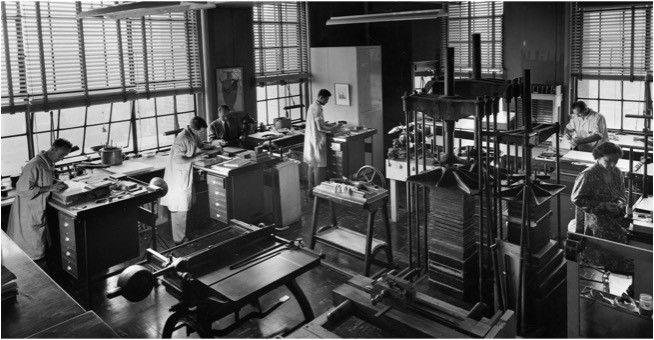
The kinds of projects that Graphic Conservation takes on fall into a few general categories. There are works of art, like this 1871 Currier and Ives lithograph of the Great Chicago Fire. The piece arrived at the lab with discoloration from acidic framing materials. The conservators cleaned up the acid stains.
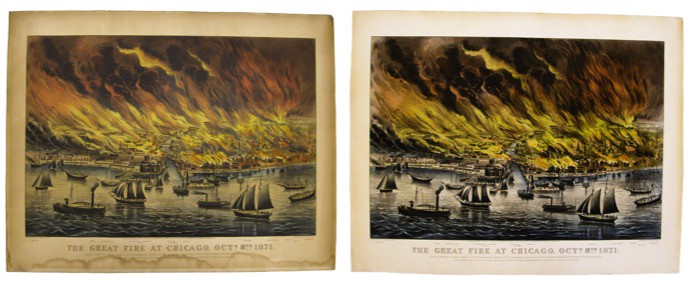
Much of Graphic Conservation’s recent growth has come from individual clients bringing in personal documents like immigration papers and marriage licenses. The lab has also worked on mementos like old letters, photographs and tickets. Below is a marriage license from 1894. The document was very brittle and was rolled up in fragments. Conservators flattened all the pieces, put them together and filled in the parts where the ink was gone.
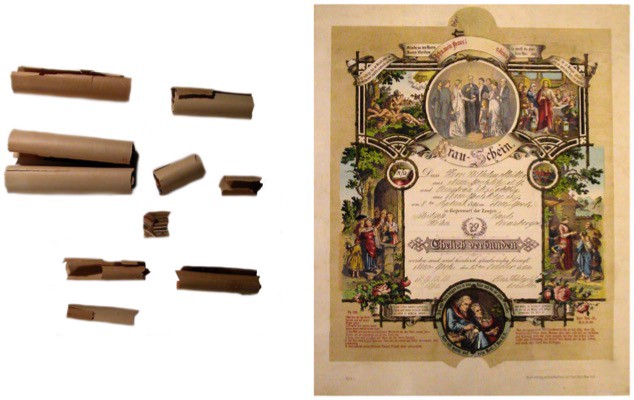
Another personal item that came into the lab was this Holocaust identification card. In this case, Graphic Conservation’s staff used Japanese tissue of a similar tone to patch the holes and stabilize the document. The goal here was repair and preservation, so the conservators did not fill in lost ink as they did for the marriage license above.
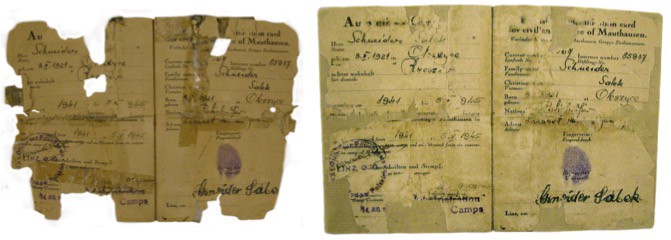
Besides art and personal documents, Graphic Conservation also works on priceless documents. The most notable recent example is the state of Illinois’ copy of the House resolution for the 13th Amendment abolishing slavery. The vellum document, one of just a handful of commemorative copies signed by Abraham Lincoln and others, had been folded and wrinkled almost to the point of illegibility.
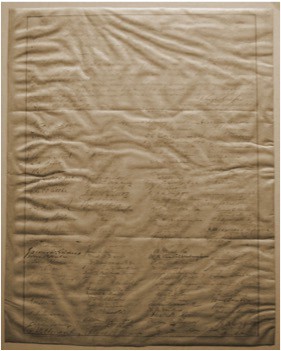
Graphic Conservation’s staff re-humidified and pressed the document repeatedly over many weeks to remove the wrinkles and help the ink re-adhere to the vellum. It did this project pro bono for the state.
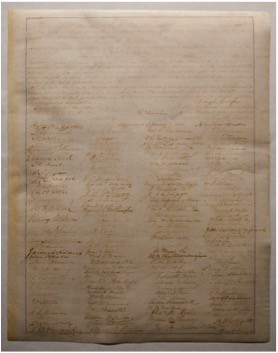
Graphic Conservation has more before and after examples on its website. If you have a document you’d like to get repaired, the company will write up a technical condition report and give you a quote for free. (The staff does need to inspect the item in person at their office in Chicago.)
Transcript
WAILIN: In 1864, a year after Abraham Lincoln issued the Emancipation Proclamation, a lithographer in Chicago made 52 commemorative copies of the proclamation. These were called broadsides and each one measured 18 by 24 inches, with a portrait of Lincoln in the middle and some additional illustrated vignettes.
TANNER: Visually, I just love kind of the cadence of it, how it’s illustrated on top. Then you read the first part of the proclamation and then it’s illustrated right in the middle and there’s a beautiful picture, a portrait of Lincoln front and center, and then it’s handwritten again at the bottom.
WAILIN: That’s Tanner Woodford. He is the executive director of the Chicago Design Museum and a lecturer at the School of the Art Institute of Chicago. Of the 52 known copies of this commemorative broadside, number 28 belonged to Tanner’s grandfather, who kept it on the wall next to his television.
TANNER: I’m not really sure, honestly, how it came into his collection and I asked him several times, and each time I got a different story (laughs), so I think at some point he was just being a grandpa, you know (laughs), just telling me stories, just trying to get me excited about history.
WAILIN: There was the story about how an ancestor rode horseback across the United States burning down towns and stole the document. There was the one about how Tanner’s grandfather found it in the wall of a house he bought. And there was the story about how the family is somehow related to Zachary Taylor or Herbert Hoover or maybe both. Whatever the real story, the broadside of the Emancipation Proclamation passed from Tanner’s grandfather to his mother to him, and by the time it reached him, it was showing its age.
TANNER: There’s a big piece of yellowed tape at the bottom where there was previously a rip and somebody else had tried to tape it and put it back on their wall. There’s a very large stain that takes up, probably, what do you think, that’s an eighth of it or so? And it looks like it was some sort of a water stain at some point in time, and then there are pretty clear rips throughout the entire thing from where it had been rolled and you know, maybe carried on horseback, I have no idea.
WAILIN: Tanner wanted to look into getting the document repaired, but he didn’t know where to go. And then one day, he was giving a friend a tour of his museum and his friend said, hey, you like art history. I know someone you should meet.
RUSS: Hello, my name is Russ Maki. I’m president of Graphic Conservation Company.
WAILIN: Graphic Conservation Company in Chicago is 95 years old and specializes in repairing and protecting works on paper, anything from fine art to historical artifacts to personal documents. On any given day, Russ Maki’s team might be removing decades-old masking tape from a Matisse or piecing together a marriage certificate found in someone’s attic or preserving an illuminated manuscript from the fifteenth century.
RUSS: It’s also, frankly, the only business I’ve ever been in when I’ve delivered a product and everyone in the room has been in tears. There’s a phenomenal connection between paper and the human record and what that means to people, and we think about that a lot here.
WAILIN: Every piece of paper that comes into the lab tells a story — not just what’s on it, but the story of its own creation and the journey it’s been on since then. And now you’ll hear the story of Graphic Conservation Company on The Distance, a podcast about long-running businesses. The Distance is a production of Basecamp. Introducing the new Basecamp Three. Basecamp is everything any team needs to stay on the same page about whatever they’re working on. Tasks, spur of the moment conversations with co-workers, status updates, reports, documents and files all share one home. And now your first basecamp is completely free forever. Sign up at basecamp.com/thedistance.
RUSS: There’s no predictability to this business whatsoever. I have no idea what’s going to walk through the front door and that frankly is some of the fun of it. Every day we get something new and sometimes it’s through, you know, a FedEx pack or UPS. Sometimes it’s an armed courier. Sometimes it’s just, someone just knocks on our door and says, “I’m here.”
WAILIN: Graphic Conservation keeps a narrow focus on paper and vellum, which is a material made from animal hide. The company’s clients include institutions like art galleries, auction houses and museums, which might not have in-house paper experts or, in the case of museums, need extra help getting an exhibit ready. Increasingly, the lab has been seeing business from individuals with personal or family documents.
RUSS: Somewhere, tucked into their crawlspace, they have a marriage license that’s their great grandparents’ or an immigration paper from Ellis Island as they came over, and it’s usually in pretty bad shape. It was probably rolled up at one time and then crushed between a book or whatever, and they realize that, “Hey, there’s only one of these, and we’d like to preserve that for our future generations.” And they find us through the Internet, which is the big change in this business. So the average client ranges from an individual who has never done this kind of work before, who doesn’t know what a conservation lab is all about, to a very sophisticated, educated client that has collected art at the highest levels for their entire lifetime.
WAILIN: The work that comes into the lab can have significant financial value, like if they’re collectibles or pieces of fine art. Or they could be items whose value is measured in sentimental or emotional terms. The company once repaired a letter that a client’s father had written to Santa Claus in 1930, during the Great Depression, admitting that he hadn’t been very good that year but asking if Santa could bring him an apple for Christmas.
RUSS: We made facsimile copies of the original for each of the siblings to have in their house, and to remind them that you know, if you ever thought that you had a bad day, you really have not had a bad day.
WAILIN: Then there are those rare jobs that involve priceless works. In 2011, the lab restored the state of Illinois’ copy of the House resolution for the 13th amendment abolishing slavery. The vellum document, which was one of just a handful of commemorative copies signed by Abraham Lincoln, needed months of painstaking work, which Graphic Conservation did for free in this case. Russ remembers the day it arrived.
RUSS: When the team, along with the security personnel, left the lab, we all stood around it, the entire team. Not a word was spoken for minutes. You’re looking at a watershed moment in American history and I think the exact word count of the Article 1 of that is 35 words: that neither slavery nor involuntary servitude except as punishment for a crime shall exist within these United States, or something to that effect. In 35 words, slavery was abolished. Today, that would be a 2,000-page document, right? So you’re looking at the utter simplicity of the prose. You’re looking at the magnificent calligraphy on this vellum document and you can just transport yourself back to February 1st, 1865, when it was signed and what Congress must have looked like that day as that was taking place. People risked their lives by signing that document and they knew they were risking their lives, and sure enough, President Lincoln was dead 75 days after he signed that document.
WAILIN: Graphic Conservation Company has a staff of eight people working in an 8,000-square foot lab with an expansive view of a railroad yard, the south branch of the Chicago River and the skyline, all serving as visual reminders of the city’s industrial past and present. The company itself comes out of this legacy. Graphic Conservation started in 1921 as a specialty department within RR Donnelley, a Fortune 500 commercial printing company founded in 1864. The department was originally called the Hand Bindery or the Extra Bindery because it focused on restoring fine books and making hand-tooled leather bindings. The group later moved from books to paper and was renamed the Graphic Conservation Department. In 1982, as the economy was in a recession, RR Donnelley sold the department to the managers who were running it, and Graphic Conservation became a private company.
RUSS: So we were part of Donnelley for the better part of 60 years and have been separate and apart from them for the last 34 now, and today our work — we do some work in book, but we’re one of the largest private paper conservation labs in the country.
WAILIN: Graphic Conservation still uses some cast iron book presses and other equipment, including a pencil sharpener, that date back to the 30s. A lot of the paper conservation process itself has also remained unchanged. And even though no two projects are quite alike, the lab sees a lot of the same problems over and over. They deal with rips, creases, water damage, tape residue or the telltale brown stains of acid burn. Maybe the document got so brittle that it flaked off into little fragments that have to be pieced back together like the world’s most tedious jigsaw puzzle. Some of the pieces that come in are newspaper pages or print advertisements or tickets, things that were never meant to last very long. Other times, something was put in a bad frame and got damaged. Russ, who became owner of Graphic Conservation in 2009 after working at a specialty paper company, doesn’t blink at much anymore.
RUSS: We had a client call us from a high-rise building. They, for some reason, on a windy day, decided to open all their windows and I think they got their art framing supplies from a big-box retailer, and they had one single hook in the wall for each of their four Warhols. Well, the Warhols flew off the walls, and unfortunately they were framed in glass. So glass shattered each one of these, or punctured each one, and we had to repair them. So yeah, we’ve seen it all. (Laughs)
WAILIN: And the lab’s conservators have fixed it all. They’re able to erase acid burns and water stains, to smooth out creases and scrape off ancient residue from adhesives, sometimes spending hours on a single square inch of paper with a microscope and a scalpel. The staff fills in holes by taking antique paper that matches the piece being repaired, reducing that paper to pulp and reconstituting it. If there’s missing artwork, the conservators can even paint in the lost image or text in a completely seamless way. The company has created new paper to fix posters, photographs and even a letter from the Boston Red Sox to Babe Ruth in 1918, agreeing to pay him a thousand dollar bonus for the season and another thousand if the team won the American League pennant that year. Russ has the before and after images of the letter framed in his office.
RUSS: He cashed both checks (laughs). So it was a good year for the Babe. (laughs)
WAILIN: I see a couple little holes, and some tape on the top left corner by the letterhead.
RUSS: Exactly. So we repaired all those areas of loss and as you can see on the right, the image post-restoration was brought back to life.
WAILIN: What are those blobs under the “Yours truly?”
RUSS: Insect damage. So insects had literally eaten away part of the paper. And you’ll see that with old documents that aren’t properly stored, frequently. It’s sad, but there are some bugs out there that really enjoy eating paper. Silverfish, especially.
WAILIN: Every job that comes into Graphic Conservation requires a series of judgment calls on what kind of treatment to use, and how far to go in preserving or repairing something. In the case of a Holocaust identification card, which arrived in extremely fragile condition, the team filled in missing pieces with Japanese tissue of a roughly similar tone, but didn’t recreate any printing because the purpose was to stabilize the document for posterity, not alter it. With the state of Illinois’ copy of the 13th amendment, which had wrinkled almost to the point of illegibility, Russ and his team discussed what to do for months before starting the treatment, which involved re-humidifying the vellum, pressing it, and slowly repeating that process over many weeks.
RUSS: Ours is a business where you get one shot at it to do it right. Again, everything we do here is the original art or the original document and there are no do-overs.
Russ’ staff members have backgrounds in studio art, chemistry and conservation. The company trains from within, hiring interns and developing them into part or full-time employees. Christina Marusich, the head conservator, started as an intern when she was a student at the School of the Art Institute of Chicago and has been working here for over 30 years. It’s amazing to think that interns are allowed to handle the documents that come into the lab. As a visitor, I was terrified of accidentally sneezing on something, like the Albrecht Durer print from the sixteenth century lying on a worktable that Russ pointed out on a tour of the lab. But interns need literal hands-on experience to learn how to do the work. Here’s Christina.
CHRISTIA: We work a lot as a team, so we’re working alongside each other and can — just learning how things should be touched and moved around and examined, so a very conscientious group here, very gentle and quiet, you know, no fast moves (laughs).
WAILIN: At Graphic Conservation, minor treatments cost in the mid to high hundreds of dollars, with more complicated jobs going well above a thousand dollars. But the company doesn’t charge for assessments. When prospective customers bring in something to be examined, the lab provides a complimentary condition report and outlines a proposed treatment. It also gives a quote, with a guarantee that the final price won’t go over that amount. But there’s no requirement to commit to anything. When Tanner Woodford brought in his copy of the Emancipation Proclamation broadside, it turned out that Graphic Conservation had worked on a different copy of that same broadside, and Russ was more excited to see Tanner’s version than anything else.
TANNER: It wasn’t even so much him trying to sell me on the process. It was more of him just being blown away by seeing another one, you know, just geeking out. That’s the thing I love about them, is they care so much about the artifacts that come in and they’re so knowledgable about them and it’s almost like when they fix them, to me, I get this feeling of really giving this thing back to the world. Russ was like, I just want to see it, if you could just bring it by sometime and I can give you a quote if you’d like, but I really just, I want to see another one.
WAILIN: Tanner did get a technical condition report and a quote from Graphic Conservation. He wasn’t ready to get the work done yet, but on Russ’ recommendation, he replaced his grandfather’s old frame with a better one. Tanner is saving for the restoration work. In the meantime, he hangs the document in his apartment near his television, just like his grandfather did.
TANNER: I could take the Emancipation Proclamation and put it in a flat file and keep it safe for much longer than if it’s hanging on a wall, but what’s the point of having the Emancipation Proclamation if you can’t enjoy it? If anybody ever wants to come see it, just shoot me an email (laughs). I might regret saying that, but (laughs).
WAILIN: When the time is right for Tanner to get his copy of the proclamation repaired, he’ll know where to go. And Russ and his staff are patient. They plan to be around for a long time, focusing on what they do best, and not chasing after bigger volumes or faster growth.
RUSS: To be candid, I don’t want this business to grow beyond a certain point. It’s kind of selfish on my part, but I really, I want to know all of our clients. I want to know every job that’s in this lab. I want to maintain our reputation as being absolutely sterling in this business, and if it gets to the point where we have more work than we can handle, the possibility exists that we can disappoint, and we’ll never do that. The element of trust is gigantic in our business because if you’re going to find us to have us do some work for you, more than likely, you’re sending us one of the most important things you own — important either in terms of financial value or in terms of sentimental or emotional value, and we pay a great deal of respect in that process. It’s important. So we’re not gonna overburden ourselves and we’re certainly not going to over promise.
WAILIN: The Distance is produced by Shaun Hildner and me, Wailin Wong. Our illustrations are done by Nate Otto. Special thanks to Tanner Woodford for telling me about Graphic Conservation Company. If you want to see before and after images of some of their projects, I’ve included them with the transcript of this episode. Look for a link to the transcript at thedistance.com. The Distance is a production of Basecamp, the leading app for keeping teams on the same page about whatever they’re working on. Your first Basecamp is completely free forever. Try the brand new Basecamp Three for yourself at basecamp.com/thedistance.

